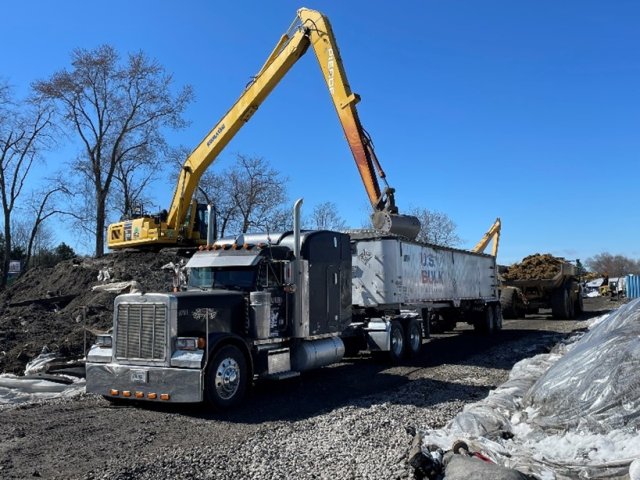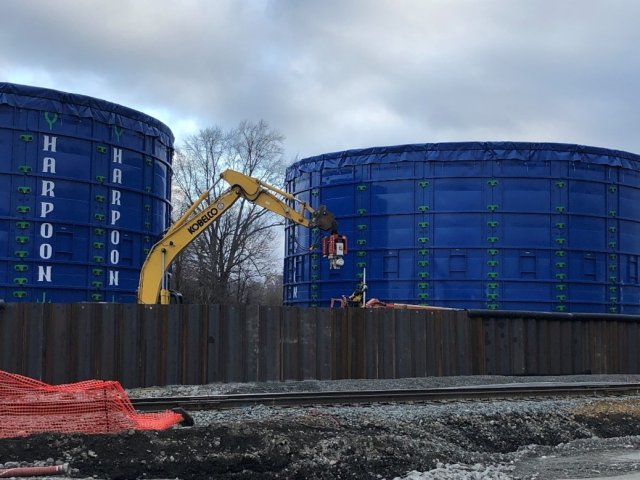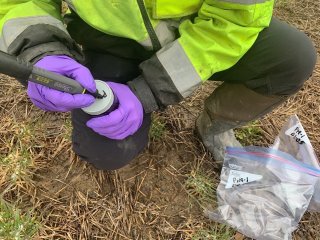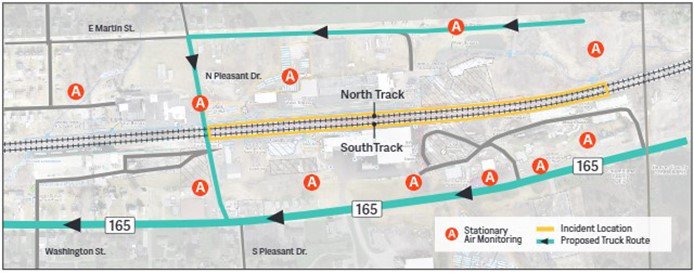Newsletter: East Palestine Train Derailment Response, 4-4-2023
Newsletter serving Serving East Palestine, Negley, Darlington, and surrounding communities
On this page:
- Progress Made
- The Week Ahead
- Community Corner
- Did You Know?
- Top 3 Questions of the Week
- By the Numbers
Progress Made

Containment Zone Around Blue Lake Tanks
Sheet piling is being installed around the large blue lake tanks at the derailment site. This will act as a secondary form of containment around the tanks. The sheet piling is fixed into the ground to make sure no wastewater leaks from the tanks and that any runoff is contained and captured.
Stream Contaminant Mitigation and Water Quality Improvement Efforts in Sulphur Run and Leslie Run are nearing completion

Air sparging involves putting air into the water so that oxygen and microbes break down chemicals, like acrylates and glycols, in sediment. Ohio EPA’s website has an interactive map with sampling results that shows the effectiveness of this technique and surface water quality continues to improve. Along with containment and vacuuming/removing water from the stream, this is a standard technique for emergency response to eliminate contaminants from water.
New Pennsylvania Health Resources
Pennsylvania residents now have access to new community-based health resources. Residents can call the Department of Health Hotline (877-PA-HEALTH) to request a checkup to help identify the root of their health concerns. A nurse will connect callers to the appropriate local health care services, and access to care is open to people without insurance or transportation. Moving forward, this health resource network will replace the Health Resource Center that has been operating at the Darlington Township Building.

Complaint Filed Against Norfolk Southern
EPA and the Department of Justice have sued Norfolk Southern over the train derailment. The suit aims to hold Norfolk Southern accountable for polluting waterways and ensure it pays all costs of the environmental cleanup. EPA is acting in its authority under the Clean Water Act and the Comprehensive Environmental Response, Compensation, and Liability Act.
The Week Ahead
At the Derailment Site
- Continued heavy truck traffic along designated routes.
- Taggart Street remains closed to the public.
- Excavation and construction work will continue at the site.
- Contaminated soil and wastewater will continue to be shipped off-site.
- Two large 1-million-gallon blue lake tanks will be used to temporarily hold wastewater, reducing the number of smaller storage tanks
In the Greater Community
- EPA’s Community Welcome Center remains open to the public from 8 a.m. to 8 p.m. daily. EPA staff are available to answer questions and address concerns.
- Air monitoring will continue at 23 locations around the community.
- EPA’s Trace Atmospheric Gas Analyzer (TAGA) mobile laboratory will continue to monitor air.
- A second air analyzer similar to the TAGA is being used. You may see it following the TAGA bus around town.
- Stream agitation and aeration is nearing completion and stream soil washing will continue.
Community Corner
Spring is around the corner and parks are a great place to enjoy warmer weather. This week, the East Palestine Youth Sports Association will start baseball practice outdoors at the City Park – games begin April 17. To reassure residents of the safety of outdoor activities like these, EPA has sampled soil in recreation areas. Results from EPA and Norfolk Southern testing in the East Palestine City Park are below screening levels (learn more about screening levels in Did You Know?). The playground and swimming pool at the park have also been cleaned and power washed.
Top 3 Questions of the Week
-
Are odors from the derailment site dangerous?
As site work continues and waste is shipped off-site for disposal, there may be times where odors can be smelled. In general, many substances can cause odors in the outdoor air but not be at levels that can harm your health, but they can still affect your quality of life…
-
What’s the difference between short-term and long-term chemical exposure levels?
Acute or short-term exposure assumes that a person has been exposed to a chemical for a short period of time. Long term, also known as chronic, exposure assumes a person has been constantly exposed to a chemical for a lifetime, or approximately 70 years.
-
Is the air monitoring equipment detecting chemicals of concern?
Yes, the air monitoring and sampling equipment are capable of detecting many chemicals of concern in the community and currently detections are below levels of concern. Some of the monitoring equipment may not detect a portion of the chemicals at lower levels–specifically n-butyl acrylate. However, there are independent tools used…
Did You Know?

Dioxins are a large family of chemical compounds that are often present at very low levels everywhere in the environment. Dioxins break down very slowly and can be created when chemicals, such as fuels and plastics, are burned. In rural areas, such as East Palestine and Western Pennsylvania, dioxins can come from farm vehicle exhaust, burning trash, campfires, and industrial factories. Pure dioxin looks like white crystalline needles, but in the environment, it generally attaches to soil and dust and is invisible to the eye.
When testing for dioxins in soil, it’s important to establish a background level. Background levels are the level of chemicals in other areas of the county or town, not related to the derailment site. In these other areas, the level of chemicals is a result of naturally occurring or humanmade activities. Naturally occurring activities are those that are not caused by humans, such as dioxins from forest fires. Human-made activities are those that are caused by humans, such as dioxins from diesel exhaust. EPA also uses screening levels to further advise on safety.
What does “screening levels” mean?
When emergencies occur that involve releases of chemicals into the environment, screening levels are a tool that responders use to learn if there is a potential for risks to human health and the environment and if there is a need for further investigation. These levels can change depending on specific details of the incident and as cleanup progresses from emergency phases to longer term cleanup. Screening values are health protective values that are below levels at which there is a potential risk to health.

